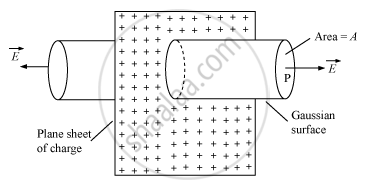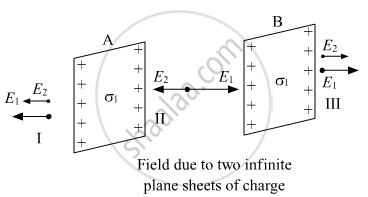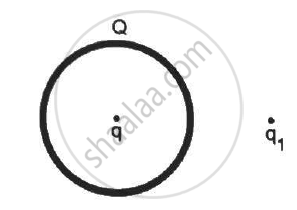Advertisements
Advertisements
Question
Using Gauss's law in electrostatics, deduce an expression for electric field intensity due to a uniformly charged infinite plane sheet. If another identical sheet is placed parallel to it, show that there is no electric field in the region between the two sheets ?
Solution
Electric Field Due to a uniformly charged infinitely large plane thin sheet with surface charge density σ, using Gauss's law

Consider an infinite thin plane sheet of positive charge with a uniform surface charge density σ on both sides of the sheet. Let P be the point at a distance a from the sheet at which the electric field is required. Draw a Gaussian cylinder of area of cross-section A through point P.
The electric flux crossing through the Gaussian surface,
Φ = E × Area of the circular caps of the cylinder
Since electric lines of force are parallel to the curved surface of the cylinder, the flux due to the electric field of the plane sheet of charge passes only through the two circular caps of the cylinder.
Φ = E × 2A … (1)
According to Gauss' Theorem,
`ø q/ε_0`
Here, the charge enclosed by the Gaussian surface,
q = σA
`ø = (σA)/c_0` ...... (2)
From equations (i) and (ii), we get:
`Exx 2A =(σA)/ε_0`
`E = σ/(2ε_0)`
Consider two infinite plane parallel sheets of charge A and B. Let σ1 and σ1 be the uniform surface charge on A and B respectively.

Therefore net electric field (E) between the two sheets can be found out as follows:
\[\text { Electric field due to sheet A }\]
\[ E_1 = \frac{\sigma_1}{2 \epsilon_o} \]
\[\text { Electric field due to sheet B }\]
\[ E_2 = \frac{\sigma_1}{2 \epsilon_o}\]
\[E = E_1 - E_2 \]
\[ = \frac{\sigma_1}{2 \epsilon_o} - \frac{\sigma_1}{2 \epsilon_o} = 0\]
Hence, there is no electric field in the region between the two sheets.
APPEARS IN
RELATED QUESTIONS
Find the electric field intensity due to a uniformly charged spherical shell at a point (i) outside the shell. Plot the graph of electric field with distance from the centre of the shell.
Find the ratio of the potential differences that must be applied across the parallel and series combination of two capacitors C1 and C2 with their capacitances in the ratio 1 : 2 so that the energy stored in the two cases becomes the same.
An infinitely large thin plane sheet has a uniform surface charge density +σ. Obtain the expression for the amount of work done in bringing a point charge q from infinity to a point, distant r, in front of the charged plane sheet.
A point object is placed on the principal axis of a convex spherical surface of radius of curvature R, which separates the two media of refractive indices n1 and n2 (n2 > n1). Draw the ray diagram and deduce the relation between the object distance (u), image distance (v) and the radius of curvature (R) for refraction to take place at the convex spherical surface from rarer to denser medium.
Using Gauss’ law deduce the expression for the electric field due to a uniformly charged spherical conducting shell of radius R at a point
(i) outside and (ii) inside the shell.
Plot a graph showing variation of electric field as a function of r > R and r < R.
(r being the distance from the centre of the shell)
A charge Q is uniformly distributed on a spherical shell. What is the field at the centre of the shell? If a point charge is brought close to the shell, will the field at the centre change? Does your answer depend on whether the shell is conducting or non-conducting?
A thin, metallic spherical shell contains a charge Q on it. A point charge q is placed at the centre of the shell and another charge q1 is placed outside it as shown in the following figure . All the three charges are positive. The force on the charge at the centre is ____________.

A positive point charge Q is brought near an isolated metal cube.
A spherical volume contains a uniformly distributed charge of density 2.0 × 10 -4 Cm-3 Find the electric field at a point inside the volume at a distance 4⋅0 cm from the centre.
